#I love you commentary on femininity and power dynamics girl
Text
ty lee is by far the most underrated atla character imo. as far as minor principal players, it’s easy to disregard her as the least fleshed out fire nation kid, the most underdeveloped. her role as a foil to any of the main characters is vague, and many people just assume she’s there to bring some sort of levity and humor to azula’s plotline. she’s dismissed as the pretty ditzy girl, or even (shudders) “the bimbo.” but when you actually make the effort to consider what we do see of her, to extrapolate from her few yet crucial scenes anything regarding her underlying motivations, you quickly realize that one of the most layered, multifaceted, compelling, intriguing, ambiguous, and perhaps even straight up insane characters in the entire show has been hiding in plain sight all along. and also that that’s the entire point.
#SHE DIDNT JUST FOOL AZULA (& al) SHE ALSO FOOLED US! THE AUDIENCE!!!#or well. most of you. not me tho im different#ty lee#I love you commentary on femininity and power dynamics girl#it feels like only mailee and tyzula shippers actually give a shit abt her#(tysuki shippers too i guess)#but even individually she is just. SO fascinating!!!!#masks & performance & acrobatics & taking you down from the inside!!!!!#I need to write an actual longass character analysis of her someday#I know I already kind of did but it was pretty shallow iirc#I think I can go deeper.
1K notes
·
View notes
Note
Hii! So every time I see your username on discord or here I always wanna ask you about it but then I don’t cause I’m socially awkward as heck and I don’t wanna seem like a weirdo - but here I am anyway - so, are you into horror movies??? I love finding horror movie fans in the wild cause I feel like none of my friends are into them 😭 who’s your fave final girl?? And what are your fave movies??
Oh my gosh. Thank you, thank you for asking this!!
If you don't mind, I'm gonna use this to go HARD lol.
I would dedicate far more of this tumblr to the genre if I could but I don't want to assault everyone's eyes with it, teehee.
Hello fellow horror fan! I'm so glad someone noticed!! Yes, I am a HUGE horror fanatic. It's like a major part of my identity!!! I love horror movies, video games, books, literally all things spooky. I've got posters all over my apartment, a stupid amount of trinkets, including a Pyramid Head plushie that's my pride and joy. :)
Horror is a fantastic genre brimming with creative ideas and it is such a healthy outlet for the anxieties of life. It is also uniquely relevant for the social scientist in me. Horror can provide great insights into how social problems become ingrained in the public consciousness, shedding light on the fears and concerns of different eras, especially in the last 100 or so years since the film industry was created. I took a monster-themed class on college last year, and am following it up with a film studies course this next semester. I write a lot about the monstorous feminine and gender studies in relation to the horror. Because, as horror reflects the concerns of the outside world, how women get treated within them is fascinating material to explore power dynamics, social expecations, and persistent fears. One of my favorites was a piece I did on feminist commentary in 2019's Ready or Not. My graduating project is going to be a zine-style work where I'm choosing 4 different horror films with 4 core aspects of the female experience and I'm so excited to start it!
To actually answer your question, my favorite horror films as of now go as:
Scream (1996)
The Thing (1982)
Alien (1979)
Ready or Not (2019)
Special mentions go out to Carrie (1976), Halloween (1978), REC (2007), Ginger Snaps (2000), and recents such as X and Barbarian. :)
Extra special mention, my favorite horror video games are Resident Evil 7 and Silent Hill 2. (Very creative, I know, lol.)
As Scream is my favorite horror series, I'd have to say Sidney Prescott is my favorite final girl. She's just such a resilient badass and I love all of the Scream films and her journey so much!
Thank you again! I hope my excitement isn't overwhelming! Feel free to message to chat about it any time!
5 notes
·
View notes
Text
Rgu ep3 liveblog under the cut! :3
Interesting that she has no memory Of meeting the prince. Is this something unique to utena or do all the rose ring wearers have this amnesia. Furthermore, what makes her so fundamentally different from the others? I do believe the show intends me to be asking these questions.
I love utena pointing out the inherent abusive nature of Himemiya not really having any friends. And the monkey mouse doesn't really count. He holds no power and cant really help Himemiya should things go south
Utena: im straight and want to date a normal boy, Kiryuu: allow me to introduce myself
Wow ok that 3 seconds of utena slapping Kiryuu for touching her hair was beautiful and perfectly showed me what the dynamic between these three is going to be
“Why do you have that” “so i could meet you” fucking liar. So many of these men suck lol
No he is not the fucking prince!! Girl you summoned the prince last episode. I know that was audience only info but like girl. Do not trust him. He hasnt explained shit and has only so far been a sly pos
Ok so confirmation utena is being left in the dark. Which is like really rude. Is she even supposed to have a ring? That would be very interesting. I hope blue hair stopwatch asks utena some questions they(?) Seem to be the kind to care about accuracy. Though they(?) Might not see a need to do what the end of the world people have also not done (explain to utena what the hell is going on)
I fucking love wakaba
Oh shit people are being mean to Himemiya. Utena get your ass over here
Hello Nanami. You are clearly important. I like you, you stood up for Himemiya.
Oh Himemiya does not need the stress of being dance queen. Shes already the rose bride. Shes already got so much going on she does not need petty school drama too. Nanami can you unnominate her?
“Ive wanted to be your friend for a long time” somehow i doubt that! I suspect you wish to be dance queen instead of Himemiya, but you dont realize Himemiya (probably, she hasnt voiced her thoughts yet) doesnt care about whos dance queen. Anyway Nanami i now hate you.
Im sorry what are those things that chu-chu pulled put of the dress box. Are they spare buttons or pills? my instinct says buttons but they have no holes
Oh nevermind i guess they were candies?? Chuchu is eating them. Ok. Sure whatever.
Oh no theyre those keep things from going moist dehydrator things. Or maybe moth balls. They were not supposed to be eaten. Anyway more important things are to be revealed, like Utena's outfit! considering its from kiryuu, my Money's on it being something super feminine utena doesnt normally wear
I WAS RIGHT
Himemiya is so based. Large crowds are way too stressful
Oh god i hate but also love how himemiya Is only going to the dance and try to make friends because Utena said so. Its so fucked up but i love it
Hello magia record uwasa girls. What is the uwasa today??
A man trap what the fuck do you mean by that
Ah i suppose they mean that the girls are going to freak out over boys. Except for utena and Himemiya.
Oh boy nanami is kiryuu’s little sister! i am curious as to how they will handle this. Theyre starting in an… interesting direction. But i can see how they could also make a commentary on their situation. But i dont know if i can trust rgu to make those narrative choices
Hang on is there no dance king??
Noooo utena is wearing the dress… i do like that she is visibly unhappy tho
Ah so Nanami thinks Kiryuu likes Himemiya? Nice touch that despite their close relationship, Nanami actually knows very little about Kiryuu's Life
Utena i dont. I dont think they are friends.
Please kill him please kill him
Nanami you bitch do not instigate Himemiya's anxiety like this! She is not competition For your brothers attention
Oh no that dress is boobytrapped in some way isnt it.
She! Is not! Competition! For! Your brother!!!!!!!
UTENA SAVE HER
YESSSSSSSSSSSSSS
Holy shit i was not expecting tablecloth dress. Props to utena For that major skill
Nanami how do you not know who utena is. Everyone screams her name when she enters school
Utena is also not competition for your brother! She does not give a shit about him except for the fact that he might be her prince. Which he isnt.
1 note
·
View note
Text
Anatomy of a Scene
Fantasy of love, or how to get your crush to call you 'honey' a bunch of times and say you're pretty
In which Pat and Pran allow themselves a moment of fantasy.
Bad Buddy, Episode 3
Director: Backaof Noppharnach Chaiwimol
Writers: Pratchaya Thavornthummarut, Bee Pongset Laksamipong, Best Kittisak Kongka
Cast: Ohm Pawat Chittsawangdee (Pat) and Nanon Korapat Kirdpan (Pran)
Nobody is around, you can talk to me nicely...You didn’t reply to my messages. You weren’t at your dorm. That’s why I’m here...Can’t we just chitchat? Are you as hard on your other friends as you are on me?...Sorry, I’m not your friend...
You can’t just sit and imagine it. You must use someone who actually uses it. Let’s do this. Let’s say we’re friends...Lovers then. To get different perspectives. Let’s say I’m an Engineering hot guy and you’re an Architecture hot girl. We’re in a relationship. And…seeking shelter from the rain and waiting to get on a bus...Why am I a girl? You are.Why so picky? Let’s say we’re both hot guys and we’re boyfriends. You’re the husband and I’m the wife. Okay?You’re such a masculine wife.
Honey, I’m getting wet. It’s raining so heavily. Gosh! People can see through my shirt. What am I going to do, honey? There’s a bus stop. Should we use it as a shelter?The roof should be around this high and curved. It will help keep the rain out.Honey, the rain just stopped but it’s sunny now. My skin is burnt.We should have a solar cell too. It will generate power to use at night. For the fans, the CCTV, and the electronic signs.Honey, you only care about the bus stop. You don’t care about me. I’m sulky now.Here’s a corpse flower for someone so pretty.Jackass! So there’re flowers growing around this bus stop too?It’s an eco bus stop. Flowers are easy on the eyes and they keep people company while waiting for the bus.Who will take care of them?Well…we will have a faucet here and the drainpipe will be directed to the flowers. That’s how we water them.
Do you like it? The new bus stop.I do. I’m just not sure if they will do too.They will. Because I do. My honey is so smart.Stop already. You’re giving me goosebumps.My booboo is the best.
This is a long one so I've excerpted the dialogue, but I wanted to keep the whole thing because there's so much here. There's the subversion of gay media and BL tropes around masculinity and femininity, commentary on said tropes, even a digression on empathy and practical design (my specific field of nerdery so I had fun), all couched within a love fantasy roleplay that these two desperately wish could be real. Pat is trying to make up for his misdeeds here. He should have put a stop to his friends' bullying of Wai at the bar that led to all this, but he's lowkey jealous of Wai being so close to Pran, even if that's not totally obvious yet. Now Pran's stressed out and mad at him so he's gotta fix it somehow.
These two care SO MUCH for each other. Their parents, despite their best efforts, weren't able to poison them against each other; they just simply like each other. And when they're vibing like this, whether it's bickering or playing or just hanging out and being with each other...it's so beautiful. It's also a dangerous game of gay chicken (LOVE this term) they're playing here, with Pat repeatedly putting a toe in the water only to pull it back, leaving Pran hot and bothered but also confused as hell, almost daring Pran to do something about it. This energy is exactly why I now completely understand how we arrive at the bet they make in the trailer. They both feel the pull towards each other, but nobody want to 'lose' by being the first to admit it.
On a meta level, Aof is definitely taking the BL audience to task a little bit here, gently chiding about expectations of strict masc/fem gender roles and the weird fetishisation of a 'top/bottom' dynamic that goes along with that (imagine there are people who won't watch this fantastic show because they can't tell which character is the 'top' and which is the 'bottom'...weirdos). By having Pat the Brick House play the 'wife' in this little scenario, he's almost saying 'See how ridiculous this all is? Anybody can be anything they want.' I like that a lot.
78 notes
·
View notes
Text
Whenever I discuss Sleeping Beauty with someone who doesn’t share my enthusiasm for Disney, they have an irksome tendency to get it muddled with Snow White; their excuse being “it has the same plot”. I’ll admit, there are some surface similarities that even the most casual viewer can pick up on: a fairytale where a princess is forced into unconsciousness and wakes up with some necking, the comic relief and villain being the most beloved characters, a little frolic in the forest with animals, the antagonist plunging off a cliff, you get the idea. In fact, Sleeping Beauty even reuses some discarded story beats from Snow White, mainly our couple dancing on a cloud and the villain capturing the prince to prevent him from waking his princess. Yet despite that, Snow White and Sleeping Beauty are two wholly different movies shaped by the era and talents of the time.
I’ve discussed how Walt Disney was never one to stick to a repeated formula, no matter how successful it was. He must have noticed the parallels between his first movie and this one, but decided to make one crucial change for Sleeping Beauty that would forever differentiate the two: the look. We all know the traditional Disney house style: round, soft shapes, big eyes; charming as it was and still is, Walt was sick of it after several decades. Meanwhile, artists like Mary Blair and Eyvind Earle were producing gorgeous concept art that rarely made a perfect translation into the Disney house style.
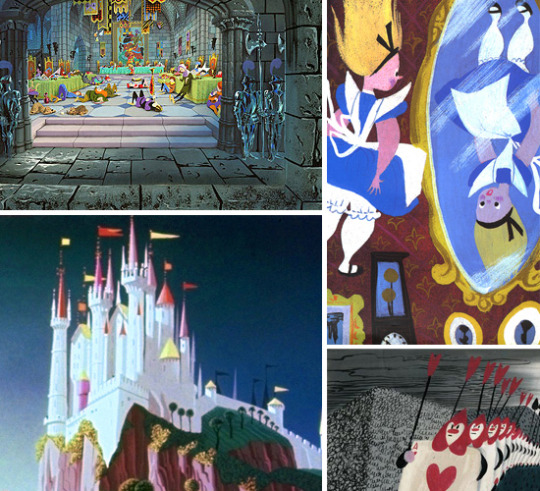
Walt wanted to make a feature that took the pop artistry of their designs and made the animation work for it instead of the other way around – which brings us to another animation studio that was doing well at the time, United Pictures Animation, or UPA.
UPA didn’t have the kind of budget Disney normally had for their animated projects, but what they lacked in fluidity they made up for in style. Watch The Tell-Tale Heart, Gerald McBoing-Boing and Rooty-Toot-Toot to see what I mean. UPA were pioneers of limited animation, taking their scant resources and creating some striking visuals with bold geometric designs. Through this, they defined the look of 50’s animation. Though perhaps unintentional, Sleeping Beauty comes across as Disney’s response to UPA, or what would happen if UPA had the funds they deserved. The characters’ contours are angular but effortlessly graceful, defining their inherent dignity and royalty. And the colors, ohhh the colors…
Because of the immense amount of work required to animate in this difficult new style (and in the Cinemascope ratio, no less) as well as story troubles and Walt barely supervising the animation studio now that he had his hands full with live-action films, television, and a theme park, Sleeping Beauty had a turbulent production that lasted the entirety of the 1950s. For a time, Chuck Jones of Looney Tunes fame was set to direct. Director Wilfred Jackson suffered a heart attack partway through production and Eric Larson, one of the Nine Old Men, took the mantle from there before Walt Disney replaced him Clyde Geronimi. And even after that, Wolfgang Reitherman teamed up with Geronimi as co-director to get the film finished after no less than three delays. Also, Don Bluth got his foot in the door as an assistant animator for this feature, beginning his short-lived but impactful tenure at Disney. Did all this hamper the movie, or did they succeed in what they set out to accomplish?
Well, one of the reasons why this review took so long was because I had a hard time not repeating “MOVIE PRETTY” and “MALEFICENT AWESOME” over and over. Make what you will of that.
The story begins as most fairy tales do with your typical king, Stefan, and his queen suddenly blessed with a baby girl after years of wishing for a child. They christen their daughter Aurora (middle name Borealis, localized entirely within their castle) and throw a huge celebration in her honor. People come from all over the kingdom to pay homage to the princess and OSMKFKSBFHFGILWBHBFC…
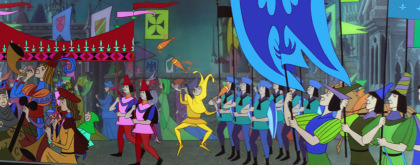
Movie pretty…
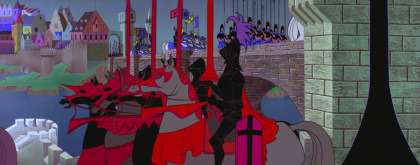
Movie pretty…
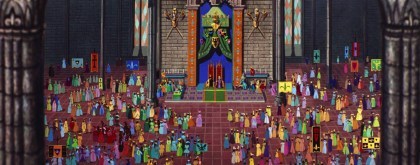
MOVIE PRETTIEEEEEE…
John Hench, Academy Award-winning special effects man and art director, turned Walt on to the idea of basing the look of Sleeping Beauty on classic medieval artwork. Thanks to him and Eyvind Earle’s insanely detailed designs and backgrounds, this is one of Disney’s most visually distinct and beautiful films. A single still from this feature wouldn’t feel out of place up in The Cloisters.
Among the party guests is King Stefan’s old friend King Hubert (Bill Thompson) bringing his young son Prince Philip. Stefan and Hubert wish to unite their two kingdoms and formally announce Philip’s betrothal to the infant Aurora.

“We were going to do it during the second trimester, but we decided to wait until she was more mature.”
By the way, your eyes are not deceiving you. That is Aurora’s mother, Queen Leah, alive and well and named. And frabjous day calloo callay, she even gets some lines! The most common joke about Disney princesses is that they don’t have moms (even Ralph Breaks The Internet went out of its way to highlight that), so as a hardcore Disney fan who often has to put up with this generalization, Leah’s existence leaves me feeling vindicated.
Once that happy revelation is out of the way, we’re introduced to our main protagonists.
Oh, you thought I was referring to Philip and Aurora? Nonononono, my friends. THESE are the true heroes of Sleeping Beauty, the Three Good Fairies.

The fairies started off as one-note side characters sharing the same personality. Think pre-Ducktales-reboot Huey, Dewey, and Louie in dresses. But the studio had a difficult time giving Aurora more depth and was having a lot more fun developing the fairies. Naturally, they became so fascinating and appealing that more screentime was given over to them. Now the story’s carried by three wonderfully fleshed out ladies who are distinct in both looks and personality: Flora’s the pragmatic tradition-adhering leader, Fauna’s the sweet scatterbrain who mediates, and Merryweather’s the feisty young upstart.
With the plot now focused on characters who held a traditionally minor role, it’s easy to read this as a perspective-flipped version of the fairytale, but there’s more to it than that. Remember in my Clash of the Titans review how I mentioned the gods literally play chess using the heroes as pieces? I tend to view the main conflict of Sleeping Beauty in the same way. The Three Fairies and Maleficent are in a constant game of good vs. evil, moving Aurora, Philip, and the rest of the royals as pawns in their plans. There’s plenty of plotting and intrigue, with both sides constantly guessing and second-guessing the other’s next maneuver, and even if you’re already familiar with the story’s trajectory you’re still left on the edge of your seat as it inches towards the fiery climax.
And dare I say it but…the fairies and their power dynamic make this Disney’s most feminist film. Yes, really. You could argue that some of the other animated movies from the Renaissance and Revival period have more notable, stronger female protagonists, and many of the live-action remakes try to be woke without really grasping the concept, but consider this: The cast of Sleeping Beauty is mostly female, the leads aren’t objectified in any manner (that is if you count Aurora as a supporting character), nor does their gender factor into their competency, each one differs in age and body type, and most of them are working together towards a common goal as opposed to against each other. Name a movie in the past decade that does the same and still manages to be entertaining (no, really, I’d love to see it). There’s even one scene that unintentionally provides great commentary on the divides in the feminist movement, but more on that later.
Flora and Fauna bless the baby with beauty and song respectively which are accompanied by a short chorus and some sumptuous graphics. I don’t think I need to reiterate that when this movie goes extra with the visuals, it GOES EXTRA with the visuals. Next comes Merryweather with her gift. To this day, no one knows what Merryweather intended to give Aurora. Flora’s the most traditionally feminine of the three so her giving Aurora beauty comes as no surprise. By comparison, Merryweather is the most forward (or unconventional, depending on your point of view). I wouldn’t put it past her to favor Aurora with intelligence, or humor, or passion, or creativity or humility or confidence or decisiveness or physical fitness or great swordsmanship or telekinesis or ice powers or one million YouTube subscribers or comfort in her female sexuality.
Me personally, I think I’ve got the best gift of all:
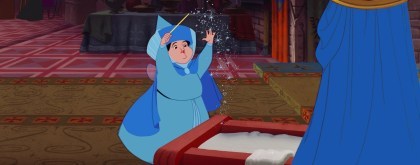
“O Princess, my gift shall be…getting all reviews posted on time for once!”
Alas, before Merryweather can bestow such a wondrous quality upon the child, she’s interrupted by a horny party crasher.
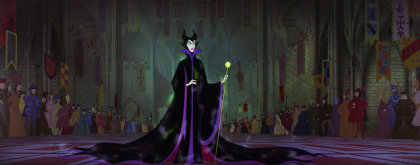
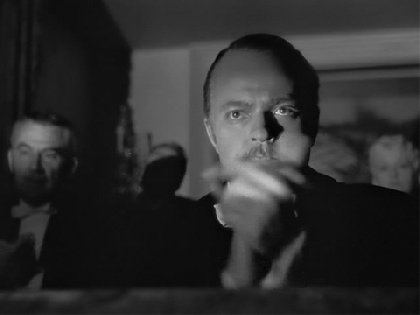
Maleficent. The Mistress of All Evil. Chernabog’s right-hand witch. The Disney villain all Disney villains strive to be. She has it all – the looks, the poise, the power, the laugh, the cunning, the ruthlessness! She doesn’t even need to sing a song because she’s already awesome enough without one. Marc Davis’ gothic design cuts a fine figure and Eleanor Audley’s subtle icy voicework is trés magnifique. As much as I enjoy Audley as Cinderella’s evil stepmother, Lady Tremaine was but an appetizer in comparison to the four-course banquet of pure villainy that is Maleficent.
This leads to a small point of contention some viewers have with Maleficent in spite of hitting top marks elsewhere: her motivation. Putting a hit out on a child for not getting invited to a measly party? Not exactly compelling, is it? And yes, it isn’t a deep motive…is what I would say if I wasn’t well-versed in folkloric tradition. In the original fairy tale and the movie (though it isn’t outright stated in the latter), the party for Aurora isn’t just your average royal kegger, it’s a christening. Back in ye olden days, christenings were very big deals. To not receive an invitation to one was a grave insult, so not extending an invite to your semi-omnipotent magical neighbor is just asking for trouble. In the fairy tale’s defense, no one had seen the evil fairy for years and assumed she was dead, though I can’t imagine how nobody thought Maleficent wouldn’t find about it eventually.

“You dare to deny me, foolish mortals? Very well, then! I shall have my own christening! With blackjack! And strumpets!”
Maleficent is proof that sometimes you don’t have to have an elaborate backstory, a god complex, a tragic past or the unfortunate luck to be on the wrong side of a conflict. Sometimes all you need is some magic, brains, class, and a whole lot of flair to be a perfect, intimidating, and unquestionably iconic villain.
Basically what I’m saying is these movies never happened. Got it?
Maleficent is disarmingly polite over being snubbed, even after Merryweather bluntly tells her nobody wanted her to come. She even brought her own gift for the baby – sixteen years of life cut short by the prick of a spinning wheel spindle, because why change into a dragon and destroy everyone all at once when you can draw the torture out over an agonizingly long time and deliver the coup de grace in the prime of a young woman’s life? That’s how Maleficent rolls, baby. She could dole out capital punishment when she has to without batting an eyelid, but causing human suffering is her bread and butter.
Stefan begs the fairies to undo Maleficent’s curse, but it’s too strong for them. Flora and Fauna insist, however, that Merryweather can use her gift to lessen the spell’s potency. Now instead of dying from that fatal prick, Aurora will sleep until she receives True Love’s Kiss™. Stefan’s not one to throw caution to the wind though, so he orders all of the kingdom’s spinning wheels to be burned in the meantime.

I just pray his kingdom’s economy wasn’t based on textiles otherwise they’re screwed.
As the peasantry celebrates Guy Fawkes Day several centuries early, the fairies ponder their next move. They’ve been around long enough to know that removing spinning wheels from the equation won’t put a damper on Maleficent’s scheme. This scene is incredibly effective in establishing two things:
Maleficent’s near-omniscient presence in the film
How well the fairies’ differing personalities play off each other
Maleficent rarely miscalculates her opponents, and that guile puts her one step ahead of the heroes, making her one of the few Disney villains to nearly reach their goal. The only mistake she makes in the entire movie is trusting her henchmen to do their jobs when she isn’t directly supervising them, though that’s more on them than her. The different methods the fairies propose to deal with Maleficent fantastically illustrate what kind of people they are. Fauna believes she’s just a miserable soul who could be reasoned with if they talk things over. Merryweather would rather take the fight to Maleficent and turn her into a toad. Flora, however, is wise enough to know Maleficent’s too wicked to plead to, too clever to bargain with and too strong to face head-on, so their best course of action is to focus on protecting Aurora through any means necessary. Her initial idea is to enchant the princess into a flower (her namesake is her specialty, after all), but Merryweather reminds her that Maleficent enjoys creating bitter frosts just to kill her flowers.
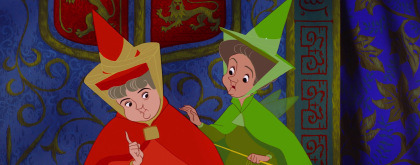
“Well we could try that but stick her in a castle with a beast for a while…nah, that’ll never work.”
Yet never one to give up, Flora alters the plan so they’ll raise Aurora as a peasant girl out in the woods. This means disguising themselves as humans and giving up magic for sixteen years so as to not attract Maleficent, but that amount of time is like twenty minutes to the fair folk. Stefan and Leah reluctantly agree to the plan, and the fairies spirit little Aurora away from the castle that very night.
Sixteen years later, Maleficent is infuriated that her minions have failed to locate Aurora, even more so when one reveals that they’ve spent the whole time looking for a baby instead of a maturing woman. In an interview with the Rotoscopers podcast, Don Bluth called Maleficent a very flat antagonist because she surrounds lackeys dumber than her so she could be the smart one among them and, again, her supposed lack of motivation. But come on, let’s not entirely condemn the bad guys for having too much faith in their underlings. It’s difficult to find minions smart enough to carry out orders but dumb enough to stay unquestioningly loyal. Usually you have to register as Republican in order to get some.
Maleficent gets her anger out in the most therapeutic way – throwing lightning bolts at her orcs, awesome – then leaves the job of finding Aurora up to her trusty raven Diablo. We then finally see the grown-up Aurora herself, whom the fairies renamed Briar Rose as a nod to the Brothers Grimm version of this tale.
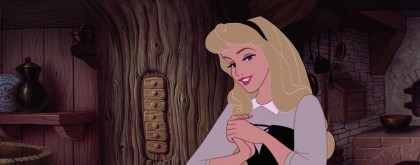
I know I’ve made the occasional case for the princesses from Walt’s era compared to the present day, and yet I have a hard time defending how…I don’t want to say bland. Bland would mean there’s nothing interesting about Aurora, and that’s a lie. She’s gorgeously designed and drawn, and even in her peasant dress she has an air of elegance and sophistication. She carries herself like a queen; her innate royalty reveals itself in her graceful movements. Mary Costa also gifts her with an excellent set of pipes. Hearing her song echoing through the forest is nothing short of magical. She’s a flower child who can talk to animals. She has dreams of escaping her adopted aunts’ loving but stifling care and being allowed to grow up, see the world, actually talk to people, and even find a life partner. She has some strong potential. It’s not that Aurora’s boring, she’s just not quite as developed as we’ve come to expect our animated female protagonists to be. I’m grateful for what we’ve got, but I only wish we could have more. What was her childhood like? How did she learn to communicate with animals? When did the fairies trust her enough to let her spend time out on her own? Did the fairies ever subtly teach her lessons in royalty through lessons and games? Heck, nobody bothers to keep her informed about Maleficent or her curse, and they act surprised when she’s shocked to learn she was a princess the whole time. I want to see what Aurora could have been like if she had known the truth already and what kind of steps she would take to defend herself. Blame the source material for this; it’s difficult to write a compelling main character when she’s supposed to sleep through most of her story.
The fairies send Aurora on a fetch quest so they can plan a surprise birthday party for her. Merryweather wants to bring their magic wands back out for the job, but Flora insists on taking no chances now that they’re in the home stretch. Fauna gets to live her dream of baking an elaborate cake (it’s thanks to her referring to a teaspoon as a “tsp” that I do it too), and Flora insists on making Aurora a gown fit for a princess using Merryweather as a dummy. And we also get one of the best burns in the Disney canon:
Merryweather: It looks awful!
Flora: That’s because it’s on you, dear.
youtube
The fairies fall into reminiscing over raising Aurora and get teary over having to let her go soon. I see where they’re coming from, they’re the ones who raised her for sixteen years. They must have so many fond memories, not to mention they put all that work into learning to properly raise a child let alone live like normal human beings seeing how two of them still can’t sew or cook without magic. I wonder what that was like –
No, NO, you CGI abominations DO NOT exist! Go back to the fires from whence you came!!
“Ugh, I’m gonna need something strong to expunge that from my eyes.”
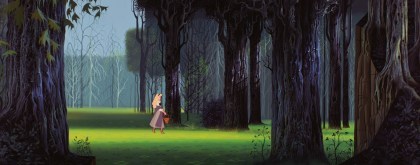
There we go.
Aurora wanders through the forest, drawing out the usual bevy of cute woodland critters with her singing. She also catches the attention of a grown-up Prince Philip (Billy Shirley) who’s more dashing and considerably less blonde than he was sixteen years ago.
By this point, the Disney animators were far more confident in their ability to draw realistic but expressive leading men, hence Philip’s expanded role from the story. He’s also the first Disney prince to have a personality; not a terribly deep or defined one, but it’s a step up from his nameless plot-device predecessors. There are some signs of him being a hopeless romantic, he gets a few funny lines here and there, has a sturdy friendship with his horse Samson, and is fiercely determined when it’s time to kick some ass. He does have the same problem as Aurora in he randomly decides to stop talking for the rest of the movie once he reaches the midway mark (at least Aurora has the excuse that she’s sleeping for that remainder), but I suppose you could chalk this up as to him wanting to spite Maleficent with his silence.
The animals steal some of Philip’s clothes so they can pretend to be Aurora’s dream prince. Aurora plays along as she sings the movie’s standout song, “Once Upon a Dream”. Philip and Samson watch until he smooths his way into the dance. Once Aurora discovers the switch, Philip gets a little too up in her personal space for my liking, constantly grabbing her hand so she doesn’t run off and pulling her closer to him. Not as horrible as what the prince does to the sleeping princess in the original story (a questionably consensual kiss is a trifle compared to how the scumbag of a prince treats her there), but still a bit iffy.
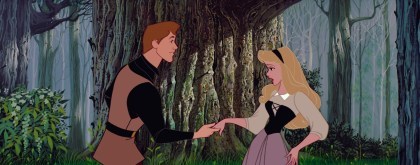
“It’s a good thing my aunts taught me to never go anywhere without a loaded pistol taped to my back.”
But once Philip backs off a little and joins in her song, they both dance together and OEHSGBJSGBLL…

I think I’m going to need surgery to get my jaw off the floor back into its proper place thanks to this movie.
As per Disney tradition, Aurora and Philip’s waltz means the two are head over heels in love with each other. But when it comes time to finally exchange names, Aurora panics and runs away, though she sticks around long enough to tell Philip to meet her family at the cottage that evening.
Back at home, the party preparations aren’t proceeding as planned. Flora’s dress looks as good as my attempts at dressmaking, and Fauna’s dessert wouldn’t feel out of place on Cake Wrecks.
A fed-up Merryweather reads Flora and Fauna the riot act and convinces them to finally take up their wands again. This produces more desirable results, though Merryweather still gets stuck with cleanup duty.
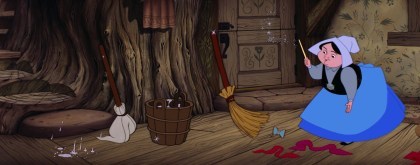
Enchanting a broom to come to life and do your dirty work? I don’t see this going wrong in any possible way.
Things start to go south when Flora and Merryweather argue over the dress color and it escalates into a full-blown wizard’s duel. This gag was supposedly based on the animators’ arguments over what was Aurora’s proper dress color. I think they should have compromised and combined both colors to make purple, which would go lovely with Aurora’s violet eyes, but what do I know. I’m just the illustration major writing a blog. Unfortunately, while the fairies remembered to cover every door, window, and crack that could expose their magic, they overlooked the fireplace. The sparkly residue of Flora and Merryweather’s fight fly up the chimney, alerting Diablo to their hideaway.
Going back to what I said earlier about this movie providing some commentary on feminism, consider this: Flora is obsessed with pink, a traditionally female color, and she gives Aurora an attribute that is oft preferred in a woman but not the most important quality, beauty. Merryweather, on the other hand, is all about blue, a color usually geared towards boys, and she has much more common sense and practicality about her. Though Merryweather and Flora are able to put aside their differences in personalities and approaches for a common goal, it’s when they refuse to compromise and begin prioritizing which color – ie. which ideology and extension of themselves – that they want Aurora to step into that they lose sight of what’s important, and allow everything they worked for to collapse on itself. It’s played for laughs very well, sure, but if not’s symbolic of the dichotomy between traditional femininity and modern sensibility that tears apart the feminist movement then I don’t know what is.
The fairies manage to fix their messes in time for Aurora’s return. She’s thrilled with their gifts but shocks them all when she announces her new boyfriend is coming over for dinner. They come clean about her heritage and betrothal to Prince Philip, and Aurora runs up to her room in tears over the fact that she’ll never see her one true love again. That and her entire life has been a lie and she’s being carted off to meet parents she knows nothing about to marry a man she’s never met and rule an entire kingdom with no prior experience or knowledge. But mostly the true love thing.
Meanwhile, Stefan and Hubert are making wedding plans over wine with “Skumps”, the preferred toast between me and my friends. Also adding to the humor is a minstrel who keeps stealing sips until he literally drinks himself under the table.
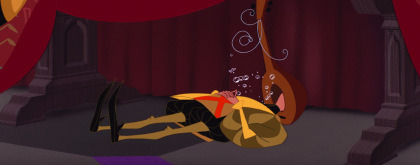
This was also his way of getting through the Black Plague, co-opted by the rest of the world six hundred years later.
Philip returns and Hubert goes to greet him. He thinks his son is thrilled at the prospect of marrying Aurora but is disappointed to learn that he’s fallen for an anonymous peasant.
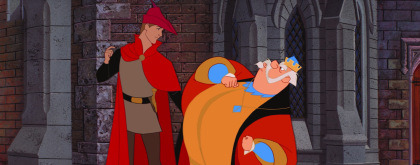
“At least tell me if she’s royalty in disguise so you don’t elope to Sicily!”
Philip rides back into the woods for his big date, leaving Hubert with the unenviable task of breaking the bad news to Stefan. As for Aurora, the fairies smuggle her into the castle and prep her for her homecoming. She’s still blue over having to ghost her forest hubby though, so the fairies give her some time to herself.
Biiiiiiiiig mistake.
So imagine you’re me, growing up watching this movie on tape on a television set with a very standard but not spectacular sound system. Then years later you download the remastered soundtrack and give it a listen while you’re falling asleep. You’ve got the whole score memorized, the volume is nice and low, it’s all good.
And then, just as you’re drifting off, you hear a ghostly voice singing in your ear “Auroraaa…Auroraaaaa…”

That reminds me, I haven’t had a chance to talk about the music yet, haven’t I? Forgive me for waiting so long to do so but my reaction to it is equivalent to the visuals. The score is taken straight from the Sleeping Beauty ballet by Tchaikovsky, the same composer as The Nutcracker, and it is lush, sweeping, sumptuous, just…

While George Bruns was mostly faithful with how the score was represented within the context of the ballet, at certain points he took the same approach as The Nutcracker Prince and rearranged the music order to underscore totally different scenes to staggering effect. The beautifully ominous music where Maleficent appears as a ball of green flame and leads the hypnotized Aurora to her doom? It’s from one of the ballet’s divertissements where Puss in Boots dances with his girlfriend. But tell me which is more fitting for a musical composition such as this – two cats pirouetting around each other in a crowded ballroom, or eerie pitch-black spiral staircases illuminated by green fire as a cursed princess inches closer to her dark destiny against her will?
youtube
The fairies realize their error and frantically search the maze of secret passages for Aurora. Though the princess resists Maleficent’s commands for only a moment, they are still too late to save her from fulfilling the curse. Maleficent gloats and leaves the fairies to wallow in their failure. It’s made even worse as the merrymaking from the oblivious revelers below ring out while they put Aurora to bed in a tower and mourn over her. It’s heartbreaking: they raised and loved her as if she were their own daughter, and they still couldn’t protect her. Everyone talks about “Baby Mine” and Bambi’s mom as huge tearjerkers, but why is this scene constantly forgotten?
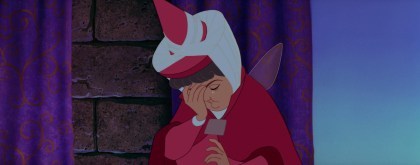
Stupid onions, stupid stupid onions…
Fauna and Merryweather can’t even begin to imagine how heartbroken Stefan and Leah will be, but Flora has a solution: put the kingdom to sleep along with Aurora until she is woken up. I understand her wanting to spare Aurora’s family some pain, but conking out an entire principality for god knows how long to cover up their failure? AND at a time when Europe was all about invading and conquering itself? Are we sure this isn’t just part of Maleficent’s overarching plan for revenge? This sounds more like something she would come up with instead of the leader of the good guys.
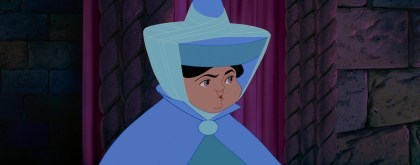
“So what happens if one of the neighboring kingdoms decides to attack while everyone’s sleeping?”
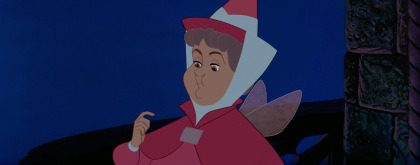
“Then we’ll put them and their armies to sleep, too.”

“And once Aurora is saved, both kingdoms will immediately wake up to find themselves thrust into a war they’re barely prepared for, is that correct?”

“Oh, you’re right, that’s a terrible idea.”

“Finally, thank you.”

“I’ll just turn them all into flowers.”

“THAT’S NOT AN OPTION!!!”
The fairies flitter about the castle grounds spreading their spell over the unwitting royal court, even putting the candles and sconces out. We have another reprise of the “Gifts of Beauty and Song” chorus now altered to sound like a lullaby, providing an interesting bit of symmetry between it and its earlier use in the film. Whereas it first underscored their blessings upon Aurora, now it plays as the fairies are giving the “gift” of sleep to the entire castle.
While Flora knocks out the throne room, she overhears Hubert muttering about Philip eloping with a peasant girl and she makes the connection. The fairies speed to the cottage just as Philip arrives there. But once again Maleficent beats them to the punch. Her goons ambush Philip and she watches them wrestle and bond him with fiendish glee.

You magnificent, kinky bitch.
Maleficent was only out to capture the one man who could break Aurora’s curse; the fact that he’s really the son of her nemesis’ allies is just icing on the cake. Flora, Fauna, and Merryweather resolve to rescue him from Maleficent’s fortress in the Forbidden Mountain.
Some movies reach the brink of greatness only to falter when it comes to the final act. Sleeping Beauty is not one of them. Everything that happens from the moment we slowly zoom in through the purple mist on to the Forbidden Mountain itself up until the storybook closes is perfection. The perfectly paced action, the animation, the music, Maleficent’s hideaway in all its decaying glory (I swear it’s like Jean Cocteau meets Frank Frazetta meets Giotto) all make for the climax of climaxes.
The fairies shrink to insect size and silently sneak through Maleficent’s creepy domain, narrowly running into guards and gargoyles at every turn. They traverse the stronghold until they find her overseeing a hellish bacchanalia in honor of her supposed victory.
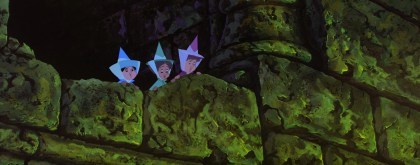
“My old gaffer would have a thing or two to say if he could see us now.”
Soon Maleficent gets bored and goes to “cheer up” her captive. Then we have it: The Moment.
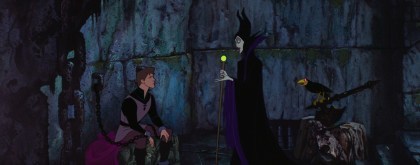
I’ve talked about this before, that one small, devious step further the villain takes to make themselves more heinous in our eyes. It’s the Wicked Witch taunting Dorothy with visions of Aunt Em. It’s the Beldam hanging Other Wybie’s remains. It’s virtually everything Heath Ledger’s Joker does. And it is this simple scene where Maleficent details what she plans to do with Philip. She spins “a charming fairy tale come true” of Aurora sleeping without aging, waiting for her prince to come to wake her. And Philip will escape the dungeon, ride to her rescue and prove true love conquers all – in one hundred years, when he’s a broken old husk of a man on the brink of death. DAMN. If you want to know why Maleficent is considered the best of all the Disney villains, it’s not just all her previously praised qualities, it’s her sheer sadism and the pleasure she takes in it.
The fairies enter and free Philip once Maleficent departs. The course of true love never runs smoothly though, so they arm him with the Shield of Virtue (licensed by Carefree Maxi-Pads), and the Sword of Truth to aid in his escape.
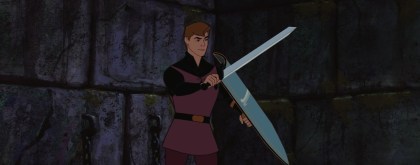
“So, why’s it called the Sword of Truth?”
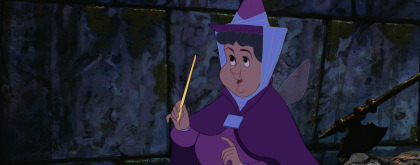
“Anyone who’s subjected to it speaks only the truth…as they bleed out and die, of course.”

“Cool, cool. On an unrelated note, I think I’m gonna go to DC for my honeymoon.”
Diablo sounds the alarm and the Battle With the Forces of Evil kicks off with Philip slashing his Sword of Truth through Maleficent’s goons.
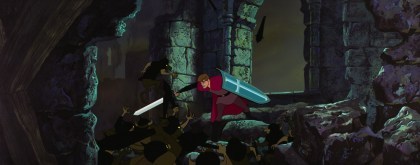
“I steal lunches from the break room fridge!” “I broke wind last Tuesday and blamed it on the dog!” “I cried like a little girl during The Good Place finale!” “I only wash my hands for NINETEEN seconds at a time!”
Philip makes his getaway on Samson and the music reaches truly operatic levels as Maleficent does everything in her power to end him. Yet Philip soldiers through it like a boss. Crumbling mountainsides, Maleficent hurling lightning from the sky and summoning a forest of thorns to block the way? Fuck that shit, he’s gotta go save his girl.
Then, as Philip cuts his way through the briars, Maleficent looks at her watch, realizes it’s No More Fucking Around O’Clock, zooms over to the castle, throws down the most intimidating challenge ever –

“Now you shall deal with me, O Prince, and all the powers of HELL!!”
– and with that, she takes her final form: a massive fire-breathing dragon.
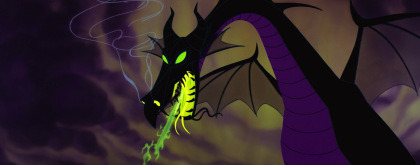

Every Disney villain who’s gone kaiju in the final act owes everything to this gorgeous terrifying beast. The dragon is an awe-inspiring unholy fusion of style, power and darkness. There’s a reason why she’s the final boss in Fantasmic; the chance to watch a live dragon battle is too cool to pass up.
Speaking of battles, Maleficent’s dragon form was animated by Woolie Reitherman, who previously brought us such gargantuan monster clashes as the T-rex brawl in Fantasia and the escape from Monstro The Whale in Pinocchio. And when you have a dragon confronting a fairytale prince, well, you know what’s coming.

Maleficent backs Philip on to a cliff surrounded by flames, leaving him only one desperate shot. With a little extra magic from the fairies, he throws his Sword of Truth at Maleficent and it plunges right into her heart.
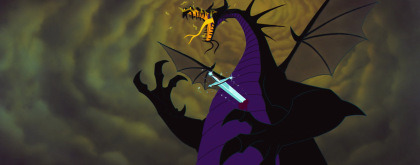
“I liked…Frozen 2…more than the first one…”
Maleficent’s spells die with her, clearing the way for Philip. He gives Aurora that wake-up smooch and everyone in the castle slowly rouses, owing their inexplicable simultaneous twenty-minute blackout to the unusually strong wine.
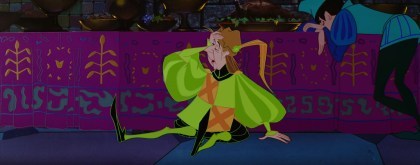
He can attest to that fact.
The royal families are happily reunited, and the film ends on Flora and Merryweather fighting over Aurora’s dress color yet again as she and Philip waltz together on the clouds using animation Beauty and the Beast would borrow thirty-two years later.
Sleeping Beauty is a movie I can never have on in the background because the moment I look up from my work I am spellbound by it. Do I need to elaborate on how this is one of the most beautiful looking and sounding movies Disney’s ever produced? Sleeping Beauty is the swan song of Disney’s first golden age of animation. For better or for worse, their animation process would switch to the rough, cost-cutting Xerox process starting with their next feature, 101 Dalmatians, and few films would reach Sleeping Beauty’s level of gorgeousness ever since.
Though a massive financial and critical hit on release, it wasn’t enough to make up for the monstrous production costs, not unlike Fantasia. Thankfully, home video sales revived interest and made it Sleeping Beauty of the top-selling VHS tapes of the decade, cementing it as a bonafide classic. It’s one of my favorites from Disney for its stunning visuals, gorgeous music, phenomenal villain and overlooked but great cast characters. Revisit it if you haven’t already.
Thank you for reading! If you enjoyed this review, please consider supporting this misfit on Patreon. Patreon supporters receive great perks such as extra votes for movie reviews, movie requests, early sneak-peeks and more! Special thanks to Amelia Jones, Gordhan Rajani and Sam Minden for their contributions!
Artwork by Charles Moss.
Screencaps from animationscreencaps.com
March Review: Sleeping Beauty (1959) Whenever I discuss Sleeping Beauty with someone who doesn't share my enthusiasm for Disney, they have an irksome tendency to get it muddled with Snow White; their excuse being "it has the same plot".
#2D animation#angelina jolie#animated#animated feature#animated movie#animated movie review#animated musical#animation#animator#animators#anthropomorphic animal#aurora#ballet#barbara luddy#battle#battle to end all battles#battle with the forces of evil#bill shirley#bill thompson#blue#briar rose#cake#charles perrault#classic disney#curse#diablo#Disney#disney animated#disney animated feature#disney animated movie
29 notes
·
View notes
Link
YOUR GUIDE TO WRITING WOMEN
There’s a lot of talk these days on “how to write a strong female character”. It’s a push back against the Disney-esque damsel in distress type character, where a woman’s biggest struggle in life was choosing the right man to marry or being preyed upon because of her beauty. Now emerges this tough as nails, self-assured, “I can change my own tires and never call me a princess” woman.
Can I tell you that both of these depictions are ridiculous?
All women are capable of being both soft and strong simultaneously. To be a woman is to exist in paradox. Yup, it’s complicated, but that’s exactly what we’re discussing in this article: how to write a woman if you’ve never been a woman and can’t think like one either. Below, we’re sharing our favorite tips and strategies for creating authentic women in your stories. You may want to bookmark this one.
Here’s a handy and printable list of do’s and don’ts for writing realistic women characters.
CLICK HERE
LET’S GET RID OF “STRONG WOMEN CHARACTERS”
Whenever I hear the term “strong women character”, I start to twitch. It’s not that I don’t approve of the idea, it’s just executed incorrectly.
Far too many male authors project masculine qualities onto a female character in an attempt to show how tough she is. Here’s an example: she can get up from a one night stand and never call or look back.
The result?
You reinforce the idea that femininity is weak.
It’s one thing to push against gender stereotypes but it’s another thing to create a fantasy woman that doesn’t ring true.
You can create a strong woman but make sure she’s a woman, and not just a dude with a skirt on.
Tweet This
You can create a strong woman but make sure she’s a woman, and not just a dude with a skirt on. In other words, she can’t be you in drag. She’s got to have the heart and motivation of a woman in every scene she’s in.
WHAT MOTIVATES A WOMAN?
I’m glad you asked.
Most women are motivated by two things: safety and service.
Women want to feel safe. But take note: there’s no universal definition to safety. This is how you can explore the individuality of your character.
What will make her feel safe in this scene and in the story as a whole? What is preventing her from reaching that place of safety? Perhaps it’s an outside obstacle, or maybe it’s her own weakness.
Always have your woman character reaching for safety, not just for a gun (well, only if you must).
Women also want to be of service. Women have a deep capacity to serve others. That’s not to say that women are subservient. On the contrary, women are in positions of power and influence as mothers, teachers, doctors, storytellers, et al. In fact, women can fulfill most any job that men can do.
The difference is that, for most women, ego is not the driving force.
This isn’t a slight against men, though. It’s just that men and women see work differently.
Men consider work as a way to showcase their ability, a beating of the chest, if you will. Women consider work as a service, whether it’s helping the customer, helping the company, or putting food on the table for her kids.
Now, I know I’m speaking in generalities here. So, don’t throw tomatoes at me just yet.
In your story, show how this woman serves others. Maybe she’s sacrificing her freedom for her sister. Or, in a twist, maybe she’s an unreliable narrator who pretends to be a loving, self-sacrificing wife when she’s really a manipulative sociopath. Extra points if you can name those stories.
While these two motivations don’t apply to all women, they’re a great jump-off point when you set out to write from a woman’s perspective.
WHAT IS YOUR MOTIVATION?
Now, let’s turn the table on you. Here are a few questions you should ask yourself before writing from a woman’s perspective:
Why are you assigning a female gender to this character?
Are you just doing it to show how cool and hip and progressive you are?
Are you writing a biting, sardonic social commentary?
Do you want to create a realistic portrait of a woman?
Is there an added level of symbolism to your gender choice?
Let the answers to these questions dictate how you assign gender to all of your characters, not just the female ones.
As an aside, one of the best types of tension in literature (and life) is male versus female. Men and women will never think in the same way which makes life so very interesting and infuriating at the same time. Using men and women to foil each other can create an delightful dynamic in your story, as long as you avoid stereotypes.
Here’s a list of stereotypes:
The delicate flower. She barely talks above a whisper, she’s sad, so terribly sad, suffering from the pain of a mysterious past.
The femme fatale. She’s a sexpot, only wears skin-tight clothes, and has a gun with your name on it.
The crazy girlfriend. She’s also got a gun.
The stay at home wife. She’s wholesome, virtuous, and dependant. Her only will for living is to be a wife and a mom.
The career driven. She’s cold-hearted and she wears designer shoes.
The most beautiful girl in the world. She’s so beautiful that she doesn’t even know it, but every other woman around her hates her.
Keep in mind that writing a female character who exhibits the polar opposite of any of these stereotypes doesn’t make your writing cool or edgy, it just makes you look like you’re trying too hard.
The best thing you can do is to avoid these stereotypes altogether. Don’t even acknowledge that they exist, and you’ll instantly improve your storytelling.
Stereotypes make a character fall flat. Stereotypes deflate what could be an interesting character.
USE A MUSE
Base the character on someone you already know. But be careful, this one’s tricky. You definitely don’t want it to be too similar that you risk a lawsuit and the relationship if it’s unflattering.
I recommend going with the “inspired by” approach. For example, model a character after your grandmother. Based on what you know of her, how would she face this particular situation? What would she do? How would she respond? Is she feisty or subdued? Is she careful or careless?
And here’s the thing: you don’t have to use just one woman as your muse. In fact, it’s better to create a composite of more than one woman. She may behave like Jan but look like Cindy.
WILL REAL WOMEN ADMIRE THIS CHARACTER?
Here’s your litmus test. Will your character, as she’s written, appeal to a female reader?
If your answer is, “I’m not sure”, it’s time to get your story into the hands of a woman. Ask her to pay special attention to the women in your story (you do have more than one, right?). A woman should be able to answer whether the women you’ve written seem authentic or fantasy.
HERE’S YOUR HOMEWORK
Talk to a woman. As you’re talking to her, pretend that she’s the character you’re writing. Things to observe:
How does she respond to you?
What’s her body language?
How does she speak? Is it fast or slow?
Does she emphasize certain words, repeat certain phrases?
This woman may not represent the entire character, but perhaps an aspect of her. “Interview” several women to create a composite character.
Interview a woman as if she is your character. Let’s take a step beyond mere observation. Explain that you’re doing character research and ask someone you know for an interview. In your interview, ask your friend or family member questions as if she were your character. For example, set up a scenario or scene from your novel and then ask questions like:
If you were in this situation, what would you do?
What would be your thought process in this situation?
What would be your main motivation?
Of course, you don’t have to go into detail, especially if you don’t want to share your story before it’s time. Instead, create similar scenarios for the interview that you can then use to understand key motivations for your female characters.
Not sure if you can find a woman to interview? Remember, women like to help and be of service to others. Good luck, and now you can throw tomatoes if you’d like.
Here’s a handy and printable list of do’s and don’ts for writing realistic women characters.
CLICK HERE
28 notes
·
View notes
Text
poorly worded crash course analysis of h.eathers
H.eathers is, in it’s basics, a reaction to the glorified, idealized, and romanticized high school experience presented by J.ohn H.ughes and the movement happening at the time that preached anti-suicide by somehow making it seem, in Veronica’s words, ‘like a cool thing to do’. This Fun Teens Out to Dance in Detention vs. the suicide epidemic was such a stark contrast that it’s not exactly shocking that H.eathers came out at the end of the decade.
The overall commentary is on suicide - more specifically how society reacts to it. Heather’s death is treated both like a national holiday and a burden, and even her death isn’t consider a top priority for the most response ( “I would’ve gone a full day for a cheerleader” ). Students that hated her or feared her suddenly treat her, ironically, like Mother Teresa based solely on a single suicide note that their teacher praises and hands out like it’s some lost Plath poem. One kid even takes notes and asks if they’ll be tested on it which plays into the underlying sense of apathy despite the fanfare that followed her death. People jump on Heather’s death as a grab for sympathy and attention, which really hits home for me as I’ve seen it happen first hand ( as many people have ). They want to attach themselves to it like they might if someone they knew went out and became a movie star. The news comes in, students cheer and hold hands in manufactured togetherness for a few days before social norms slowly settle back in leading to the rumors about Veronica, Kurt/Ram’s death.
The overwhelming response is polar to the complete lack of mention by any student outside of Duke that Martha attempted suicide - which she then mocks and lays down her whole thing with the finishing “just another case of a geek trying to imitate the popular people and failing miserably. is that pate?”, clarifying that suicide is seen as trendy since popular kids were doing it (later again touched on by Heather McNamara’s attempt at attempting), and then dismissed as though it were nothing. The only one horrified by any of this is Veronica, who slaps Duke and makes my day.
There’s then the whole underlying men v. women/masculinity n femininity stuff weaved in really subtly in the nuance of women using words and strategies vs. men using brawn and guns and shit, but that’s a whole other thing that I just don’t feel like going into but trust me it’s there.
Also a general overlay of society pressuring kids to fit into certain tropes and all that but most teen films have that so it is Not Important to me in this.
HEATHER C - is the ideal American girl. She pretty, she’s popular, etc. However, despite all her haughty attitude and presenting herself as the top of the food chain, even Heather has to answer to someone ( fuck you David, you Remington dickhead get a JOB!!! ). While Heather is an inexcusably asshole, we see that she is human, that she does have weaknesses. I could go into her and Veronica’s dynamic for a million years so ask about that sometime, I’m ready. Heather is used for her status that she made personal sacrifices for even after her death.
HEATHER D - Veronica’s foil. Scapegoat for Heather C. The opposite reaction of Veronica. Where Veronica sees an opportunity for change, Duke just sees an opportunity. She is completely a product of her treatment from C. How stuff can change you for the worse, how power can go to your head. Instead of her previous abuse making her more empathetic, she turns hard, even going after her own friend. ( this seems really harsh but I love Duke, don’t come for me ).
HEATHER M - Heather is played up by the fanon as related and uwu Sad Baby despite the fact that she’s not Really Suicidal. The problems she presents before her attempt are purposefully weak ( with a sprinkling of the serious ). She’s following trends completely, she never would have considered taking her own life without the influence and response that Heather/Kurt/Ram’s received. She’s the most empathetic of the three, the more influenced by whatever has the strongest pull. With Chandler, she was an asshole, with Duke she was made to feel inconsequential, and with Veronica she felt cared for.
VERONICA - Veronica is the ultimate observer. She’s an outsider on the inside. She’s seen the worst in people and still believes in the best. She commits atrocities and yet we still want her to succeed. There’s so much to Veronica and I’m not going to go into it on this because, y’know. That’s my entire blog.
JD - An observer. Only sees the bad and is the much more drastic counterpart to Veronica. Kind of reps the whole Anti-Suicide movement - he thinks he’s making a change but he’s making it worse.
MARTHA - the outsider. The foil to the Heathers, essentially. Veronica’s first pick to build a bridge because A.) Martha needed someone after what she went through and B.) It’s the most drastic and Point Making bridge Veronica could have built.
KURT/RAM - nah fuck them I’m not talking about them, the fandom can stop treating them like uwu soft gay bbs any time lol. Similar to Heather C in the response to their deaths and the complete acceptance of a single note vs. a life time of contradicting behavior.
I’d also like to note that the humor is in the absurdity. It’s dark comedy, it’s not for everyone. Also that many scenes are made to upset you ( the r*pe scene in the background meant to unsettle you simply because it’s not played up or presented dramatically ).
#♔ iv. .°•.* ─ ❛ ᴛᴀᴋᴇ ɪᴛ ᴅᴏᴡɴ ⇢ ooc.#jess bitching //#i guarantee i missed shit bc there's so much and i think ahead of myself so! if you have any question send an ask lol rip#there's a lot of symbolism as well so maybe another time i'll touch on that#there's just a lot okay#rape //#rape tw#suicide //#suicide mention //#long post for ts /
3 notes
·
View notes
Photo
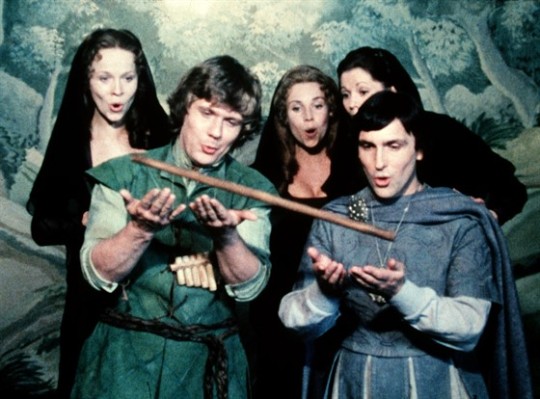
NOTE: Despite the fact The Magic Flute was originally released on Swedish television on January 1, 1975, it debuted as a theatrical film in the United States later that year in November. As per the rules I set out for this blog, Bergman’s The Magic Flute will be treated as a theatrical film.
The Magic Flute (1975, Sweden)
I imagine that when some people read that this film review concerns an adaptation of an opera, they will stop reading at the word, “opera”. As someone who was taught classical music from an early age, I get it. Opera seems inaccessible, and a several-minute aria just to get a plot point across can seem daunting (not just for the audience, but the performer too). But as with any artistic medium, there will always be points of entry for newcomers. Ingmar Bergman’s 1975 adaptation of Wolfgang Amadeus Mozart’s opera The Magic Flute is one of them. The Magic Flute is one of the more accessible and most performed operas in Western classical music, and it just so happened to be Ingmar Bergman’s favorite. Bergman saw the opera when he was twelve years old, leaving an immediate impression. Unable to afford the record, he attempted to recreate The Magic Flute with marionettes at home. By the mid-1970s and having cinematic and stage production experience in his oeuvre, Bergman dared to imagine filming his favorite opera.
There are numerous cinematic opera adaptations. But they are underseen and largely unavailable to North American viewers – I am not including filmed opera performances in this distinction (e.g. the Metropolitan Opera’s popular live feeds that are presented in movie theaters and public television). Invariably, Bergman’s The Magic Flute is mentioned on the rare occasions when opera films are discussed. Sometimes, due to contempt for opera or a lack of understanding about classical music, it is the only such opera film discussed, and usually never from a musical lens.
In this adaptation, Bergman attempts to meld the distinct artifices of cinema and opera together. The viewer is never transported to a fantastical world, as the film possesses no “fourth wall” to begin with. We see an audience – look closely and you will see Bergman and cinematographer Sven Nykvist in the audience – waiting in anticipation during the overture, and the action takes place on what appears to be a homely community opera house. On occasion, we will see the performers backstage preparing for their musical entrances. When their performance begins, they inhabit the world of the opera.
This peculiar dynamic Bergman creates is less believable on a more gargantuan stage. The stage’s production design and deliberately low-budget (but charming) costume design suggests we are experiencing a performance given by a small community opera company. La Scala this is not, nor is it the Met or Paris Opera. Bergman wished to shoot the film at the Drottningholm Palace Theatre in Stockholm, a small eighteenth-century theater that still uses mechanisms dating back to its inception. Unfortunately, that theater was deemed too fragile for film equipment. Nevertheless, Bergman and production designer Henny Noremark (who also served as co-costume designer along with Karin Erskine) concocted a workaround. On a soundstage at the Swedish Film Institute, the production design team painstakingly crafted a facsimile of the Drottningholm Palace Theatre’s interior. The Magic Flute appears to be an inexpensive production, but it is anything but. The stage is intimate, inviting, personable.
In brief, Mozart’s opera is set in Egypt and concerns a mother-daughter dispute rife with misunderstanding. The protagonist, Prince Tamino (Josef Köstlinger), is contacted by the Queen of the Night (Birgit Nordin). She asks him to free her daughter Pamina (Irma Urrila) from the clutches of a high priest named Sarastro (Ulrik Cold; doesn’t that sound like a villainous name?). After being shown a portrait of Pamina, Tamino falls instantly in love with her – that’s opera logic, you know. Tamino is joined in his adventures by Papageno (Håkan Hagegård), an overly talkative bird-catcher dressed like a bird. But Tamino will learn more about Sarastro’s priestly order and becomes interested in joining. The Magic Flute has been interpreted as heavily influenced by Masonic themes, and modern analyses clash as to whether its portrayal of the Queen of the Night is misogynistic (see: Sarastro’s belief that Pamina should not be subject to the Queen’s feminine manipulations) or proto-feminist.
Also featured are the conniving Monostatos (Ragnar Ulfung) and, in the second act, Papagena (Elisabeth Erikson). The Magic Flute benefits from an excellent recording by the Swedish Radio Symphony Orchestra under the direction of conductor Eric Ericson.
Opera films tend to adhere closely to the work composer and librettist. Bergman exercises some liberties with Mozart’s music and Emanuel Schikaneder’s libretto*. Instead of the original German, this film uses a Swedish-language libretto by the poet Alf Henrikson (this Swedish-language version debuted at the Royal Swedish Opera in 1968). No offense against the Swedish language, but this Swedish-language version of The Magic Flute makes the musical phrasing awkward. Mozart’s opera was composed with German in mind. German may not be a listenable as Italian in an operatic setting (it could be worse, it could be English – as in the otherwise excellent 1951′s The Tales of Hoffman, adapted from Jacques Offenbach’s opera of the same name), but this should have been Bergman’s first choice.
The decision to cast singers with sweeter voices rather than full, unamplified ones assumes that an audience cannot tolerate a soprano’s high notes. "Der Hölle Rache kocht in meinem Herzen" – commonly known as the Queen of the Night aria – demands full-bodied womanly rage to sing. The soprano should sing this forcefully, but not harshly. It feels like Bergman is asking Birgit Nordin to hold back her vocals during the aria (which also sounds rushed in the second half). Whether in an opera or an operatic adaptation for film, this is not an aria that should be sung with anything less than full power. Bergman should let Nordin sing this aria as it should be sung. To do so invites a starker contrast between those few minutes and the rest of the film – a show-stopper as Mozart intended it to be. Nevertheless, Bergman’s decision to prioritize acting over musicality – however it grates upon my senses – works for all the other roles. Nykvist’s cinematography pulls close to the actors’ faces, demanding more facial acting from the cast (who are all lip-syncing) than they might be used to. The cast succeeds in this challenge, approaching a type of acting they are unaccustomed to.
The setting of Bergman’s Magic Flute strips away much of the opera’s original Egyptian setting and settles for a vaguely European design. The Queen of the Night-Sarastro conflict becomes a parental dispute, as Bergman makes Sarastro Pamina’s father. A few trios in Act II have been eliminated. Also in Act II and to the film’s detriment, Bergman changes the order of appearance of two Papageno-centric scenes to the point where they no longer make any narrative sense.
Where Bergman’s The Magic Flute triumphs is its representation of the nature of live opera (and, by extension, live theater). When one experiences an opera or theater, everything onstage is an interpretation, a living fiction. The events onstage and the music transport one from reality, without ever truly leaving that reality. Moments in which Swedish text of the libretto appears in front of the actors (sometimes held by the actors themselves) precede the creation and widespread use of surtitles in opera houses today. By making somewhat indistinguishable the actors’ transition between the “real” and operatic worlds (during the intermission’s last moments, we see actors smoke a cigarette and two others playing chess), Bergman shows that the viewer is as much a part of the performance. We assign as much meaning to the unreality of an opera as the actors. The whimsical comedy of The Magic Flute – one filled with imperfect protagonists and subplots that never quite cohere – makes Bergman’s metatextual commentary more apparent and approachable.
The Magic Flute followed two heavy Bergman dramas in Cries and Whispers (1972) and Scenes from a Marriage (1973). Having watched twelve of his forty-five feature films, The Magic Flute is, by some distance, the liveliest Bergman film I have seen. I do not expect any others to be as light, as comedic as this – the key difference might be that Bergman is adapting material, rather than using an original screenplay of his. It is refreshing to see an Ingmar Bergman without a gripping existential crisis, mentally disturbed characters soliloquizing their plights.
In The Magic Flute, the relationship between our lived reality and theatrical artifice holds for every person that engages with the performing arts. Debuting in Vienna in 1791, The Magic Flute, Mozart’s final opera, was not composed for aristocratic patrons, but commoners. Almost two centuries later, the in-film audience of Bergman’s adaptation is comprised of various genders and races. That universality of the theatrical experience is reflected in their faces, interspersed on occasion alongside scene changes and still moments. The universality of Western classical music, in this case Mozart’s, is etched in their gazes. Nykvist’s camera keeps returning to one young girl in particular. She is always smiling, obviously enchanted by The Magic Flute. Perhaps she is feeling things akin to Bergman the first time he experienced The Magic Flute – unburdened by cynicism, more accepting of unreality.
My rating: 7.5/10
^ Based on my personal imdb rating. Half-points are always rounded down. My interpretation of that ratings system can be found in the “Ratings system” page on my blog (as of July 1, 2020, tumblr is not permitting certain posts with links to appear on tag pages, so I cannot provide the URL).
For more of my reviews tagged “My Movie Odyssey”, check out the tag of the same name on my blog.
*A librettist is the opera term for a lyricist. The Magic Flute is a Singspiel opera, which means it contains snippets of dialogue. Schikaneder wrote both the lyrics and dialogue.
#The Magic Flute#Trollflöjten#Mozart#Ingmar Bergman#Josef Köstlinger#Håkan Hagegård#Birgit Nordin#Irma Urrila#Ragnar Ulfung#Ulrik Cold#Britt Marie Aruhn#Kirsten Vaupel#Birgitta Smiding#Elisabeth Erikson#Emanuel Schikaneder#Alf Henrikson#Sven Nykvist#TCM#My Movie Odyssey
1 note
·
View note
Photo

Like many outsiders, Frank Ocean betrays an obsession with identities and objects just beyond his reach. In an excerpt from the Boys Don’t Cry magazine released last week alongside an album, Blonde, a visual album, Endless, and a music video for the song “Nikes,” Ocean writes about an image of a young girl in a car. “I put myself in her seat then I played it all out in my head. The claustrophobia hits as the seatbelt tightens, preventing me from even leaning forward in my seat. the pressing on internal organs. I lean back and forward to release it. Then backwards and forward again. There it is—I got free.”
Later in the note, he remembers, “Raf Simons once told me it was cliché, my whole car obsession. Maybe it links to a deep subconscious straight boy fantasy. Consciously though, I don’t want straight—a little bent is good.” Ocean is describing his car fanaticism, an obsession that has defined him, while simultaneously articulating a deep alienation. He does not fit the stereotype of the straight, suburban boy with an encyclopedic knowledge of automobiles. In fact, he seemingly finds it easier to access his memories through the figure of the young girl, whose seatbelt invokes a gut memory of entrapment.
To say that Blonde is not straight is an understatement. The album—along with the visual album, art magazine, and “Nikes” video—bends genre, bends gender, and bends time. Ocean drives his car across countries and decades, meandering, and zig-zagging. Returning again and again to scenes from his childhood and adolescence, Ocean leaves linearity by the side of the road. Music becomes a vehicle capable of impossible movement, carrying us inside a thought, inside a moment, inside a fantasy.
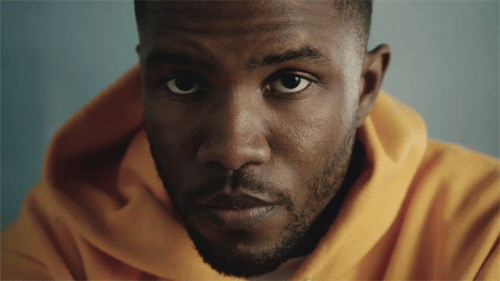
Blonde’s unconventional narrative mirrors the real-life story of how the album got here, and all the different forms it has taken throughout its extended gestation. Since the release of his last album Channel Orange in 2012, Ocean has been teasing at this return, releasing various release dates only to abandon them. The journalists who have been burned by broken promises and the fans who have eagerly awaited Ocean’s sophomore album have condemned the singer as outrageously, unnecessarily evasive. Perfectionism is one thing, but what’s the point of setting deadlines only to defy them? Or building a staircase when you should be making music? Or stepping so far out of genre that half the tracks on your album don’t even have a drum beat?
Frank Ocean dashes expectations and refuses definitions for a reason. His phobia of labels and limits isn’t just an affectation—its essential to his art and his self-expression. In 2012, on the cusp of Channel Orange’s release, the critically acclaimed artist published a description of his first love, a male friend who didn’t romantically reciprocate. Ocean’s sexuality is, as he describes it, “dynamic”—a self-assessment that hasn’t stopped journalists from pigeonholing him as bisexual or gay. This refusal of conventional terms is becoming more and more common among younger generations, who increasingly reject binary constructs. Dynamism is at the heart of both the artist and his oeuvre. It’s also part of an ever-evolving definition of queerness.
Just like Blonde, which refuses to stand still, queerness is less of a location or endpoint and more of a horizon. In the words of queer theorist José Muñoz, “Queerness is not yet here… Put another way, we are not yet queer. We may never touch queerness.” Here queerness is defined not by a destination or a term, but by constant motion. For Ocean, this theorization is tantamount. As Ocean told GQ in 2012 in regards to his uncategorized sexuality and music, “I’m giving you what I feel like you can feel… The other shit, you can’t feel. You can’t feel a box. You can’t feel a label.” By refusing to claim an identity, he reserves the right to constantly redefine.
This is not to say that Blonde fully evades the question of homosexuality. In “Good Guy,” Ocean croons about being taken on a date to a “gay bar.” The date then fizzles into romantic disappointment: “I know you don’t need me right now / And to you it’s just a late night out.” Ocean’s LGBT influences are also on display in “Ambience 001: In a Certain Way,” a short interlude on Endless that samples the voice of iconic drag queen Crystal LaBeija.
But Ocean references bitches just as often as he references boys. It’s the kind of irreverence and mutability that makes Ocean such a difficult gay icon, and such an intriguing queer one. Frank does not seem inclined to take on any responsibilities as the hip-hop world’s pre-eminent gay artist—a label he’s never claimed and does not seem likely to. While he wrote eloquently and openly on the Orlando Pulse shooting, Blonde doesn’t contain any similarly political gay statements or eulogies.
Throughout the album, visual album, and magazine, he seems more preoccupied with disorientation than orientation. While Apple Music lists the album as Blonde, the cover art reads Blond. This interchangeable masculine and feminine is at the heart of the video for “Nikes,” a song named after a traditionally masculine hip-hop fetish. The video weaves together shots of Ocean in glitter and heavy makeup with nude men and women, dancing in angel wings. Ocean’s ability to sample from gendered aesthetics and expectations even as he pulls from various genres and indulges in multiple media reveals his unflinching commitment to flexibility in all things. And while Frank makes this restlessness look like art, and even makes it look like fun, it’s more than just lighthearted experimentation. To define oneself leads to pressures and responsibilities—to produce another Channel Orange, or to pen the next gay anthem. On “Nikes,” Ocean shouts out Trayvon Martin, musing, “That n**** looked just like me.” Identities, from race to sexual orientation, can trap, define, even kill. Artistically, they can stagnate. And so, Ocean keeps moving, citing over 40 musical contributors on an album that refuses categorization or ideological co-option.
Of course, the way Ocean approaches queerness is partly pragmatic. Hip-hop has never had a gay superstar. As a community, the hip-hop world is still plagued by homophobia, and prohibitive molds of masculinity. While male rappers are expected to abide by certain conventions, there appears to be a loophole for MCs who have expanded their artistic reach. One example is Young Thug, a rapper who was featured in Calvin Klein’s Autumn/Winter 2016 campaign. In a video for the brand, Young Thug spoke to his penchant for pulling outfits from menswear and womenswear, explaining, “I feel like there is no such thing as gender.” While Young Thug’s remarks triggered a bit of a backlash, with hip-hop fans and media outlets musing on his sexuality, there also seemed to be an increasing understanding that queerness isn’t synonymous with homosexuality. It’s also important to note that Young Thug stated his progressive philosophy in a fashion forum, not on a track or in a Breakfast Club interview. Jaden Smith was similarly embraced by sartorial tastemakers for his androgynous style, proving that while gendered experimentation might be rare in hip-hop, its male denizens can find precedent and encouragement by dipping into outside worlds.
Like Kanye West before him, Frank Ocean is exploiting this distancing loophole by presenting himself as a multi-faceted artist. By making stairs, shooting film, and producing magazines, Ocean defies the rapper label just as he shirks a gay or bisexual identification. By deliberately refusing to be known as a gay rapper or a bisexual man in hip-hop, Ocean can partially skirt the homophobic bias that the hip-hop community can’t seem to shake.
Queer, which is not a single, stable identity, might be more accurately described as an active critique of the normal and the normative. Normality is not universally accessible, or universally desired. The queer subject, forced to the outside, is given the complicated gift of perspective. Blonde is made rich through this looking in. Frank Ocean, a sexually fluid, black man who attempts to defy gender, is just the outsider to take on America in 2016. In Ocean’s capable hands, the familiar becomes strange. In Boys Don’t Cry, Ocean queers Americana, photographing a man putting on his underwear in a field, and sharing images of young men with automobile logos shaved into their heads. In a featured poem, Kanye West manages to write a deeply unsettling ode to the most ubiquitous fast-food joint in America: McDonald’s. In “Nights,” Ocean is homeless in Texas after being run out of Louisiana by Hurricane Katrina. In all these complementary projects, things that are quintessentially American—McDonald’s, cars, the South—are taken and made unfamiliar and disquieting through the lens of race, trauma, and sexuality. Ocean’s unique commentary, and the alienation that informs it, is a quiet, powerful critique.
In the wake of rights-based victories like gay marriage, some queer activists have questioned a movement that prioritizes the chance to be the same over the freedom to be different. This is where Ocean, and his rejection of the straight, comes into play. In a piece from Boys Don’t Cry titled “Boyfriend,” he writes, “I could say that I’m happy / they let me and my boyfriend become married / I could say that I’m happy / but cross my heart I didn’t notice.” It’s as if Frank is deliberately playing with expectations or hopes for his gay politics by claiming apoliticism. Of course, queer folks might argue that this apathy toward marriage equality is a deeply political rejection of homonormativity. And Ocean goes both ways—on “Seigfried,” he ponders and then ultimately dismisses the allure of the heteronormative. Ocean wonders if his lack of convention makes him a “fool”—“Maybe I should move / Settle down, two kids and a swimming pool.” But in the end, he wagers, “I’d rather live outside.”
In Blonde, “living outside” is a personal sacrifice and a risky wager. Barred from the acceptability of straight love or the stability of a legible gay identity, Ocean has no choice but to keep moving, and keep longing. Vexation and disappointment are everywhere, and satiation seems impossible. With such an uncertain future, he looks to the past as he heads for the horizon. On “Futura Free,” the final track on Blonde, Ocean excerpts an old conversation between his childhood friends from the hip-hop crew Odd Future. On an album marked by romantic disillusionment, this return evokes the family making and platonic love that is so vital to queer communities. In a world where love disappoints and normalcy isn’t an option, there’s an art to making your own family, and finding intimacy in unexpected places.
Ocean’s steady stream of emotionally unavailable partners, unanswered texts, unfulfilled dreams and missed connections speaks to a specific brand of disoriented desires. In common parlance, sexuality is often reduced to orientation. But queer theory proposes that the desiring subject is so much more than the gender of the person they have sex with. This is certainly the case for Ocean—Blonde isn’t about who he loves, but how he loves them. His bravely broadcasted intimacy is proof that boys do cry, that sexuality can be fluid, that love can be unrequited, platonic, queer, and cruel. He makes the familiar strange, but he also makes the strange familiar. Even the most traditionally masculine straight boy will see pieces of himself in Ocean’s fluid oeuvre—childhood memories that could belong to any of us, texts that sound familiar, landscapes we’ve seen, half-asleep, out the window. In queering the world and chronicling the queer, Ocean’s bent masterpiece brings under-represented modes of desire to the mainstream.
via DailyBeast // 8/25/16
0 notes